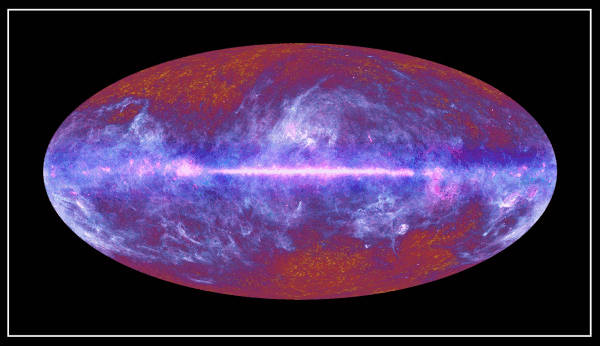Planck all-sky image depicts galactic mist over the cosmic background
5 July 2010
An all-sky image from Planck's recently completed first survey highlights the two major emission sources in the microwave sky: the cosmic background and the Milky Way. The relic radiation coming from the very early Universe is, to a large extent, masked by intervening astronomical sources, in particular by our own Galaxy's diffuse emission. Thanks to Planck's nine frequency channels, and to sophisticated image analysis techniques, it is possible to separate these two contributions into distinct scientific products that are of immense value for cosmologists and astrophysicists, alike. |
| This multi-colour all-sky image of the microwave sky has been synthesized using data spanning the full frequency range of Planck, which covers the electromagnetic spectrum from 30 to 857 GHz. The sequence of images shows the all-sky map with, superimposed, the locations of previous Planck image releases, a selection of extragalactic sources, and a map of molecular clouds. Individual images and detailed captions can be accessed by following the image links on the right-hand menu. Credit: ESA, HFI and LFI consortia. |
ESA's Planck observatory surveys the entire sky in the microwave region of the electromagnetic spectrum, covering the frequency range 30 to 857 GHz. The main goal of the mission is to track down the Cosmic Microwave Background (CMB), the primordial radiation emitted during the very early stages of the Universe, and its tiny temperature fluctuations, reflecting the seeds from which cosmic structures would later form and subsequently evolve. However, as this first all-sky image reveals, the cosmic signal is literally hidden behind a fog of foreground emission, arising mostly from the interstellar medium (ISM), the diffuse mixture of gas and dust filling our Galaxy.
"The grainy structure of the CMB is clearly visible in the high-latitude regions of the map, where local emission is not predominant," explains Jan Tauber, Planck Project Scientist. "By contrast, a good part of the sky is dominated by the Milky Way contribution, shining strongly along the Galactic Plane but also extending well above and below it, albeit at a very much lower intensity."
A quick glimpse at this newly released all-sky image might suggest that it is only possible to isolate the 'background' CMB signal from the galactic foreground in small areas of the sky. In order to achieve what will be the sharpest image ever obtained of the early Universe, however, it is necessary to separate the two components over a considerable portion of the sky. This is accomplished through complex image analysis software, which has been specifically developed for this mission by the Planck science teams. The analysis relies on the exceptional resolution and sensitivity of the data collected by Planck in all of its nine frequency channels.
The ISM in the Milky Way is made up of clouds of gas and dust with varying composition, temperature and density. Fortunately, the various phases of the ISM produce most of their emission in different regions of the spectrum; these characteristic signatures facilitate the separation of the disparate foreground contributions and their removal from the maps.
"Planck's unique frequency coverage is the key to capturing as much information as possible about the foreground emission and to achieving an optimal modelling of the diffuse medium in the Milky Way," notes Tauber. "In this way, it will be possible to lift the 'mist' that conceals the CMB over most of the sky and to access the all-important cosmological information that it contains," he adds.
| Scanning the microwave sky with Planck. Credit: ESA. (Larger versions of this animation, along with a detail caption, can be accessed by following the video link on the right-hand menu.) |
This all-sky image has been obtained by combining data spanning the full frequency range of Planck, probing different physical processes, both local and cosmological; it thus represents a remarkable synthesis of the wide range of information that Planck is able to provide. Although it shows the combined features of many sources of emission, individual frequency maps are much more clearly dominated by the emission of one or a few sources, facilitating their separation. For example, even though in this image the CMB shows through clearly only in limited regions, the central frequencies of Planck are actually dominated by the CMB itself over much larger areas.
The Planck scientific teams are currently working on the data collected during the first 12 months of operations, teasing out the cosmological signal from the combination of all nine maps of the sky. The careful analysis of the galactic foreground emission that is required in this process will – as a by-product - improve tremendously our knowledge of the structure of the Milky Way; among many other important astrophysical results, it will enable a detailed study of the large-scale structure in our Galaxy and, in particular, a three-dimensional reconstruction of the structure of the ISM including its tenuous magnetic field.
Notes for editors:
Planck maps the sky in nine frequencies using two state-of-the-art instruments, designed to produce high-sensitivity, multi-frequency measurements of the diffuse sky radiation: the High Frequency Instrument (HFI) includes the frequency bands 100 – 857 GHz, and the Low Frequency Instrument (LFI) includes the frequency bands 30 – 70 GHz.
The first Planck all-sky survey began in mid-August 2009 and was completed in June 2010. Planck will continue to gather data until the end of 2012, during which time it will complete four all-sky scans. A first batch of astronomy data, called the Early Release Compact Source Catalogue, is scheduled for public release in January 2011. To calibrate the data to the exquisite precision required to extract the main cosmology results will require about two years of data processing and analysis. The first set of processed data will be made available to the worldwide scientific community towards the end of 2012.
Contacts:
Jan Tauber, ESA Planck Project Scientist
Directorate of Science & Robotic Exploration, ESA, The Netherlands
Email: jtauber rssd.esa.int
rssd.esa.int
Phone: +31 71 5655342





